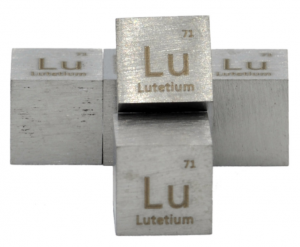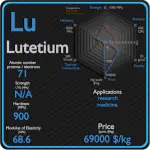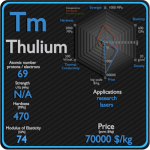This article contains comparison of key thermal and atomic properties of thulium and lutetium, two comparable chemical elements from the periodic table. It also contains basic descriptions and applications of both elements. Thulium vs Lutetium.

Thulium and Lutetium – About Elements


Source: www.luciteria.com
Thulium and Lutetium – Applications
Thulium
The pure metal and compound have few commercial uses: because it is very rare and expensive and has little to offer, thulium find little application outside chemical research. Thulium has been used to create lasers. Thulium lasers require less cooling and function very well at high temperatures and are used in satellites. When stable thulium (Tm-169) is bombarded in a nuclear reactor it can later serve as a radiation source in portable X-ray devices. Thulium-170 is gaining popularity as an X-ray source for cancer treatment via brachytherapy. Thulium has been used in high-temperature superconductors similarly to yttrium. Thulium potentially has use in ferrites, ceramic magnetic materials that are used in microwave equipment. Thulium-doped calcium sulphate has been used in personal radiation dosimeters because it can register, by its fluorescence, especially low levels.
Lutetium
Lutetium is not extensively used metal. Most lutetium is used only in research. One of its few commercial uses is as a catalyst for cracking hydrocarbons in oil refineries. It is used in detectors of positron emission topography that detects cellular activity of the body.
Thulium and Lutetium – Comparison in Table
| Element | Thulium | Lutetium |
| Density | 9.321 g/cm3 | 9.841 g/cm3 |
| Ultimate Tensile Strength | N/A | N/A |
| Yield Strength | N/A | N/A |
| Young’s Modulus of Elasticity | 74 GPa | 68.6 GPa |
| Mohs Scale | N/A | N/A |
| Brinell Hardness | 740 MPa | 900 MPa |
| Vickers Hardness | 520 MPa | 1100 MPa |
| Melting Point | 1545 °C | 1663 °C |
| Boiling Point | 1950 °C | 3402 °C |
| Thermal Conductivity | 17 W/mK | 16 W/mK |
| Thermal Expansion Coefficient | 13.3 µm/mK | 9.9 µm/mK |
| Specific Heat | 0.16 J/g K | 0.15 J/g K |
| Heat of Fusion | 16.84 kJ/mol | 18.6 kJ/mol |
| Heat of Vaporization | 191 kJ/mol | 355.9 kJ/mol |

